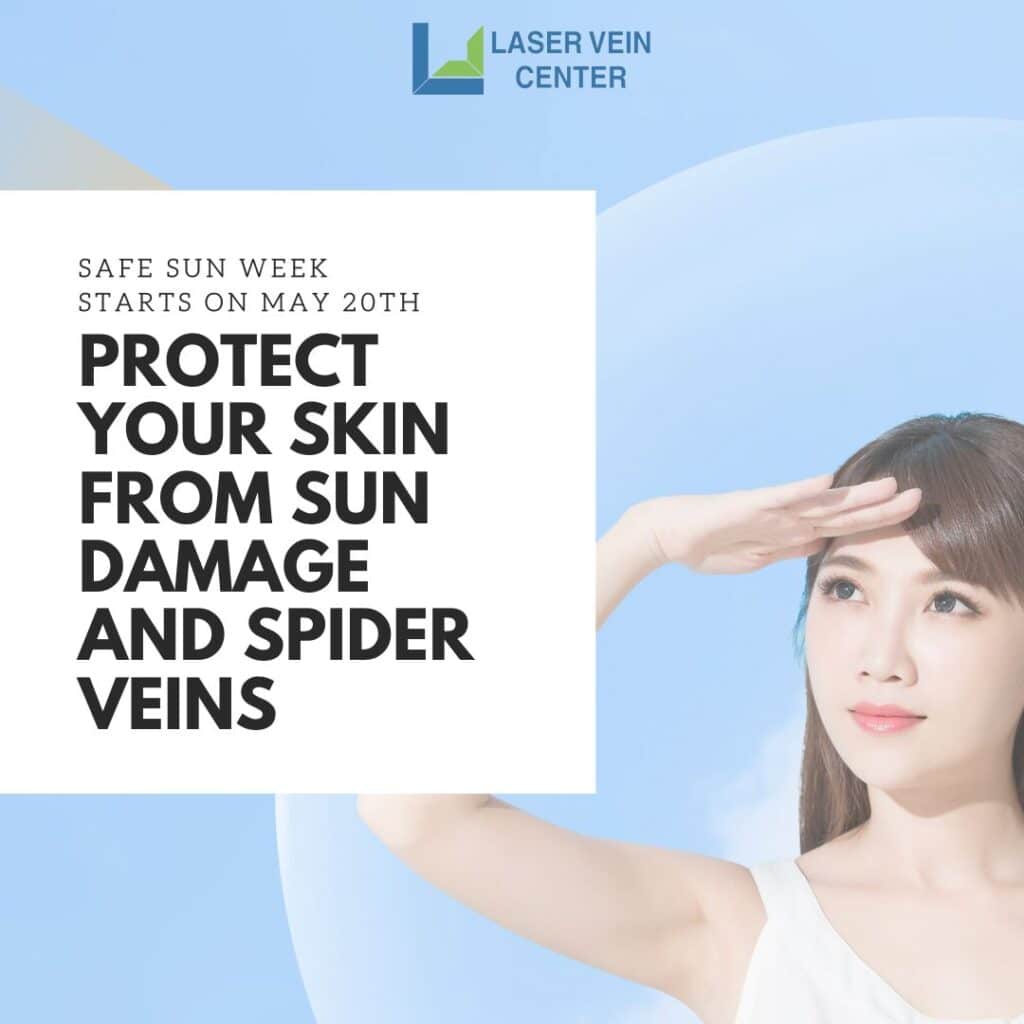As we observe Safe Sun Week starting May 20th, it’s crucial to focus on the effects of sun exposure on our skin, particularly how it can lead to the development of spider veins. At St. Louis Laser Vein Center, we understand the importance of protecting your skin to maintain its health and appearance. Here’s what you need to know about sun damage, its link to spider veins, and how to prevent and treat them effectively.
Understanding the Impact of Sun Exposure
Sunlight is vital for health, but excessive exposure can harm the skin in several ways. Ultraviolet (UV) rays from the sun can break down collagen and elastin, essential for maintaining the skin’s elasticity and strength. This breakdown leads to premature aging and increases the risk of developing spider veins. Small, damaged veins appear on the skin’s surface, especially in areas frequently exposed to the sun, such as the legs and face.
Why Limit Sun Exposure
Limiting sun exposure is essential to protecting the skin from UV damage and reducing the risk of developing spider veins and other skin conditions like sunburn and skin cancer. Prolonged and unprotected sun exposure can exacerbate vein dilation, which contributes to the formation and prominence of spider veins.
Ways to Limit Sun Exposure
Here are effective strategies to protect your skin from excessive sun exposure:
- Use Broad-Spectrum Sunscreen: Apply a broad-spectrum sunscreen with an SPF of 30 or higher to all exposed skin, even on cloudy days. Reapply every two hours or more frequently if swimming or sweating.
- Wear Protective Clothing: Long-sleeved shirts, pants, wide-brimmed hats, and sunglasses can provide physical barriers against the sun’s rays.
- Seek Shade: Whenever possible, seek shade, especially during peak sun intensity hours between 10 a.m. and 4 p.m.
- Avoid Tanning Beds: Tanning beds emit UV rays that can damage your skin like the sun, increasing the risk of spider veins and other skin issues.
What are Spider Veins?
Spider veins are generally non-symptomatic but can develop in shades of red, purple, or blue, often web across the skin. Spider veins can appear anywhere on the body but tend to show up across the legs, arms, and face the vast majority of the time. While spider veins don’t often come with any pain or swelling, many individuals who suffer from this condition are unhappy with their sudden appearance and how it fits into aesthetic goals. While the development of spider veins is frequently linked to underlying varicose veins, they are also linked to age, significant weight changes, hormonal fluctuations that might occur during pregnancy or menopause, past trauma, and excessive sun exposure over time.
Treating Spider Veins Resulting from Sun Damage
If you’ve already developed spider veins, there are effective treatments available that can reduce their appearance:
Sclerotherapy has proven to be a highly successful and safe spider vein treatment with the added benefit of a quick recovery time for more severe cases of spider veins or to treat those in more sensitive areas across the face. This procedure can be performed in the comfort of the attending physician’s office over the course of a single afternoon and uses nothing more than local anesthetic to make the service comfortable for the patient. Once the treatment area is sufficiently numb, the physician injects a foam or liquid sclerosant into the problematic vein. This injection irritates the spider veins to the point of collapse and closure. Eventually, the veins are naturally reabsorbed into the body, leaving skin clear and smooth. While liquid sclerosant is very effective, more physicians are turning towards foam options as this tends to bind more securely to the vein’s interior, avoiding interference with surrounding blood flow.
Like Sclerotherapy, some physicians may recommend Endovenous Laser Therapy for patients looking to treat small spider veins near the skin’s surface. This procedure involves using a local anesthetic to numb the treatment site before a small probe is inserted through a minimal incision point. The probe allows the physician to target the problematic veins using precision laser energy to collapse and close the vein.
Conclusion
Safe Sun Week is a great reminder of the importance of sun protection for your skin’s health and appearance. Limiting sun exposure can protect your skin from spider veins and other harmful effects of UV radiation. If you are dealing with spider veins, St. Louis Laser Vein Center offers several treatments to help manage and reduce their appearance. Remember, protecting your skin from the sun is not just about aesthetics—it’s about maintaining long-term skin health. Visit our website or contact us to learn how to keep your skin healthy and vibrant while enjoying the outdoors safely.

